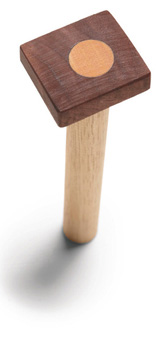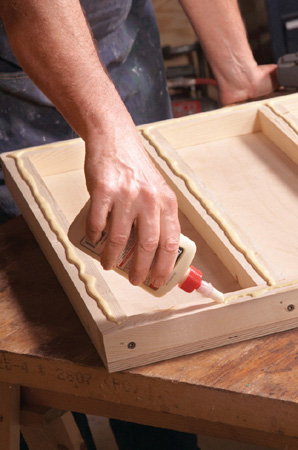
1 Build the torsion box legs. Assemble a 2x2 frame with screws. Be sure the joints are flush. Run a heavy bead of wood glue, then screw or nail the plywood skin so all edges are flush.
Materials list
2-1/4" x 30" x 72" maple top
5 bd. ft. of maple
Sheet of 3/4" plywood
1-1/2 sheets of 1/2" plywood
1/2 sheet of 1/4" plywood
Three 8' 2x4s
Two 9" bench vises
Two packs of desktop fasteners
Cutting list
PART |
QTY. |
DIMENSION |
MATERIAL |
DESCRIPTION |
A |
1 |
2-1/4" x 30" x 72" |
Maple |
Top |
B |
4 |
1-1/2" x 1-1/2" x 23-1/2" |
2x2 |
Torsion box rails |
C |
8 |
1-1/2" x 1-1/2" x 26" |
2x2 |
Torsion box stiles |
D |
4 |
1-1/2" x 3-1/2" x 28" |
2x4 |
Top/bottom support |
E |
2 |
3/4" x 3" x 29" |
Maple/pine |
Front trim |
F |
4 |
3/4" x 4" x 4" |
Maple/pine |
Feet |
G |
4 |
1/2" x 23-1/2" x 29" |
Plywood |
Torsion box sides |
H |
1 |
1/2" x 29" x 48" |
Plywood |
Back |
J |
2 |
1/4" x 22" x 25-1/2" |
Plywood |
Doors |
K |
2 |
3/4" x 20-1/4" x 43" |
Plywood |
Top/bottom shelf |
L |
1 |
3/4" x 19-1/4" x 43" |
Plywood |
Middle shelf |
M |
1 |
3/4" x 2-1/4" x 43" |
Maple/pine |
Bottom shelf trim |
N |
1 |
3/4" x 1" x 43" |
Maple/pine |
Middle shelf trim |
P |
1 |
3/4" x 3/4" x 43" |
Maple/pine |
Top shelf trim |
Q |
2 |
1/4" x 3/4" x 29" |
Maple/pine |
Side trim |
R |
6 |
3/4" x 1-1/2" x 19" |
1x2 |
Shelf cleats |

1 Build the torsion box legs. Assemble a 2x2 frame with screws. Be sure the joints are flush. Run a heavy bead of wood glue, then screw or nail the plywood skin so all edges are flush.
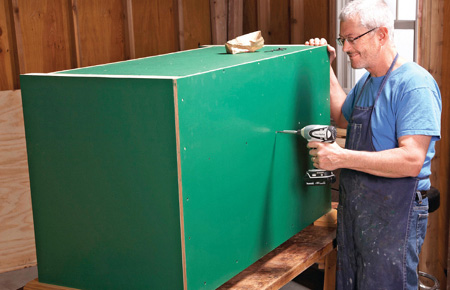
2 Attach the back. Screw the back to the shelves and legs. It’s best to paint the plywood surfaces before final assembly.
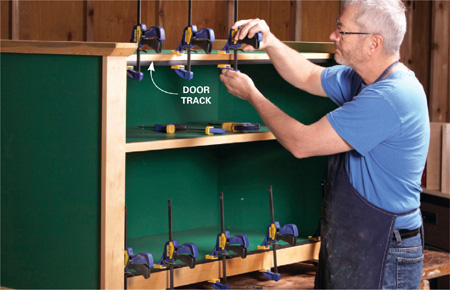
3 Mount the door tracks. Apply a bead of construction adhesive and clamp the door tracks in place. Cut the bottom track about 1/2 in. shorter than the opening. Center the track to leave gaps at each end so the door motion sweeps out accumulated sawdust.
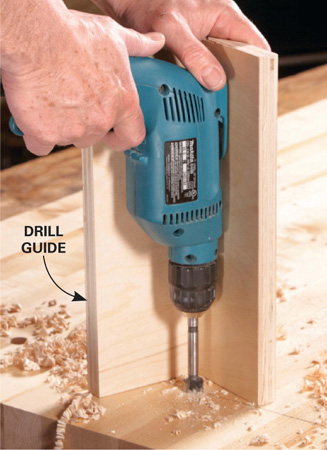
4 Drill the bench dog holes. Fit a drill with a 3/4-in. drill bit and drill the dog holes. A drill guide made from a couple of plywood scraps attached at 90 degrees ensures perpendicular holes.
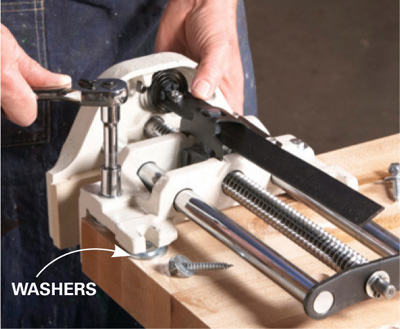
5 Bolt the vise to the top. Mount each vise so the metal jaws are slightly below the surface of the wood top. This may require some shimming. I used metal fender washers to fine-tune the vise position.
DIY accessories
Bench jack
The purpose of a bench jack is to support long, wide stock such as a door. To make a jack, screw together a couple of pieces of 3-in. x 36-in. pine or plywood to form a “T.” Drill 3/4-in. holes in the face of the jack. Clamp the bench jack in the tail vise, and insert a dowel at the desired height (see photo).

Bench dogs
Bench dogs work with the vise to hold stock on the bench surface. They’re easy to make. Drill a 1-in.-deep hole in 1-1/2-in. x 1-1/2-in. blocks of hardwood, then epoxy 3/4-in. dowel stock into the holes. To accommodate different stock thicknesses, cut the block to 1/4-in., 1/2-in., 3/4-in., 1-in. and 1-1/2-in. heights.
